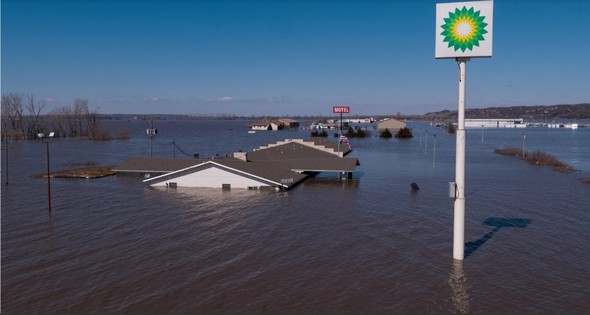
Flooding has started early in Iowa and more rain is on the way. Flooding can create many issues for Underground Storage Tanks (USTs). When tanks are submerged, damage to UST systems is expected. The impact of this damage must be evaluated to determine what steps are necessary to safely place your site back into service without risk of a release.
If your site has been efffected by flood waters the UST system must be evaluated to determine the following:
- If flood waters caused any damage to the UST system
- If there has been a release of product from the system
- If a release has occurred, what corrective action must be taken to asses the extent of the release.
In 2008, the DNR issued an emergency policy since agency rules do not adequately address what actions must be taken after flood impact to a UST system. This policy has helped to establish a procedure for owners and operators to follow and document before they can bring their UST systems back into service.
UST Flood Emergency Policy & Guidance
Applicability: This policy and procedure applies to all UST sytems submerged by floodwaters or otherwise affected by flooding, such as saturation damage/exposure.
UST systems affected by flood waters must be inspected by an Iowa licensed installer, installation inspector or compliance inspector. The flood damage certification form located at the end of the Flood Guidance. The department recognizes that this may create delays in re-opening facilities; therefore alternatives may be approved depending on the demand for inspections and potential delays.
The DNR is in the process of adopting state regulations in response to changes in federal UST requirements. A number of significant changes will be made, including these new requirements:
- Testing of secondary containment & overfill prevention equipment every three years
- Annual inspection of leak detection equipment
- 30-day and annual walkthrough inspections
The EPA has indicated the first cycle of the three-year testing must be completed by October 13, 2021, for those facilities subject to testing, regardless of when the proposed state rules become effective. The DNR is not currently requiring this testing for existing systems, but we are providing this notice so owners can plan for testing once state regulations are finalized. Please check the DNR UST/LUST Regulations tab on our webpage for draft rule documents and further updates.
Owners and operators must have their UST system inspected and an inspection report
submitted to the department by a UST compliance inspector certified by the department under 567—Chapter 134. Compliance site inspections shall be conducted within 24 months of the prior compliance site inspection.
It is the responsibility of the owner to review and respond to the inspection report provided by the certified compliance inspector and complete the corrective actions specified in the compliance inspection report within the specified time.
What should I do before my inspection?
After you have scheduled your inspection, take the time to prepare your site. Preparing your site will allow for a smoother inspection and the need for a follow-up inspection will likely be avoided.
- Gather all of your records.
o Tank and piping leak detection records for the last 12 months
o Any documents about general repairs to the UST system
o Results from your last CP test (if applicable)
o Current copy of your financial responsibility
- Check for and remove any liquid and/or debris found in sumps and containments.
- Ensure all current certified operators are up to date on training and certificates are available on site.
What if a suspected release is found during a compliance inspection?
Upon notification of a suspected release by the certified compliance inspector, it is the responsibility of the owner/operator to report the condition to the DNR and undertake steps to investigate and confirm the suspected release.
Do I need to correct all of the compliance violations or deficiencies from my compliance inspection?
Yes, Owners and operators must take all actions necessary to correct any compliance violations or deficiencies in accordance with IAC Chapter 135. Corrective action must be taken no later than 60 days of receipt of the inspector's report. Documentation must be provided to the compliance inspector that the violations or deficiencies have be corrected. The DNR may grant additional time to remedy a violation.
DNR UST Section
Phone: 515-725-8364 or 8324
Email: cara.ingle@dnr.iowa.gov or brandy.beavers@dnr.iowa.gov
|